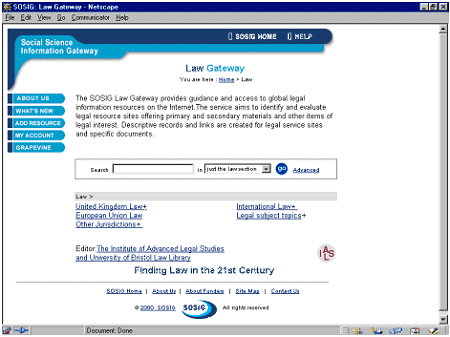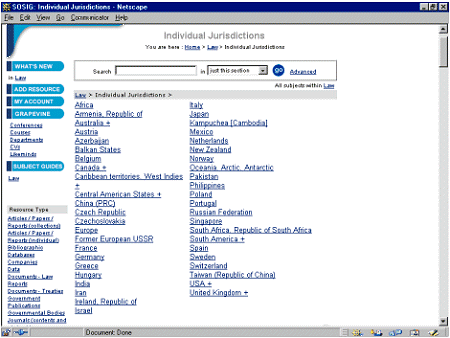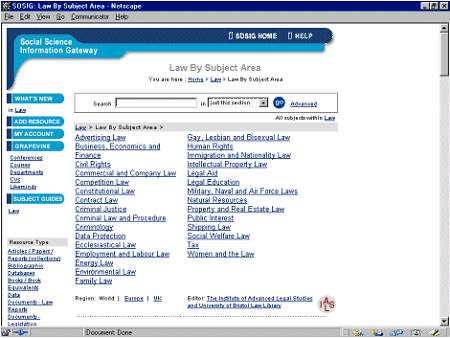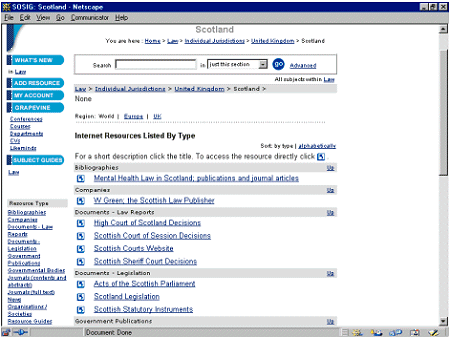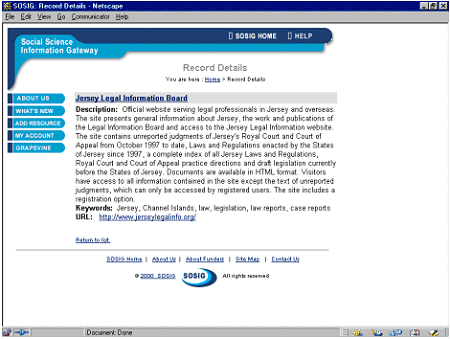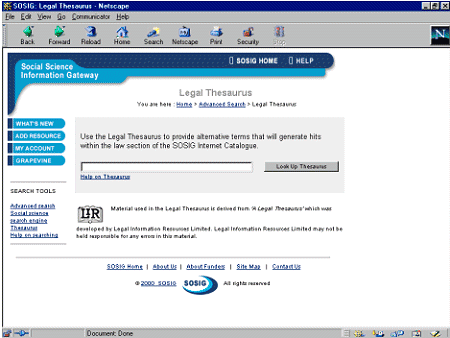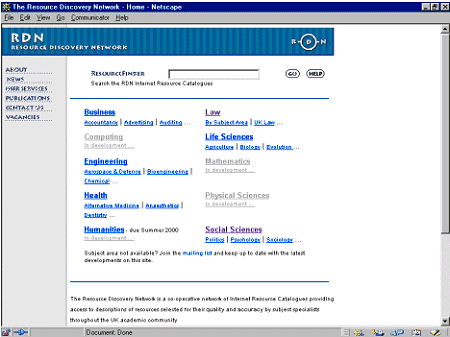JILT 2000 (1) - Steven Whittle
A National Law Gateway : developing SOSIG for the UK Legal CommunitySteven Whittle A wealth of legal information is becoming available on the Internet but academic lawyers, practitioners and their students cannot always afford the time to track it down or be sure of its quality, coverage and currency. This paper describes the aims and outlines the features and facilities offered by a new Law Gateway service, being developed by SOSIG, the Social Science Information Gateway. Keywords: legal information, information gateways, usability This is a Commentary published on 30 June 2000. Citation: Whittle S, 'A National Law Gateway : developing SOSIG for the UK Legal Community' , Commentary 2000 (2) The Journal of Information, Law and Technology (JILT). <http://elj.warwick.ac.uk/jilt/00-2/whittle.html>. New citation as at 1/1/04: <http://www2.warwick.ac.uk/fac/soc/law/elj/jilt/2002_2/whittle/> Traditionally, in the UK and internationally, law has always been quite hard to find, update and interpret. Law has needed careful handling, required the intervention of legal information specialist (the law librarians of old) to collect, manage and distribute legal materials, facts and sources. The Internet era of electronic information and public service publication changes nothing and changes everything. Electronic resources offer academics and lawyers access to materials with a depth and immediacy that expand the possibilities of both scholarship and professional practice. With this enormous potential comes a potential problem. An accumulating wealth of legal information is available on the web but legal researchers cannot always afford the time to track it down or be sure of its currency and stability. They need the services of specialist legal information providers (the law librarians and research tools of today). A new Gateway to Law on the Internet, developed for SOSIG by the Institute of Advanced Legal Studies Library in partnership with the University of Bristol Law Library, is aiming to deliver such a service. The project seeks to establish a research resource, targeted at the UK legal community, to help realise the potential and distribute the rewards of the new information age. The SOSIG Law Gateway provides guidance and access to high quality international legal information resources on the Internet. The service identifies and evaluates legal resource sites, offering descriptive records and links both to service sites publishing primary and secondary materials and to specific documents of legal interest - helping to make it easier to find useful sites for a given jurisdiction or legal subject area.
The service is easily accessed over the web from any networked computer. It aims to help users find: primary legal documents (legislation, law reports and treaties) government documents, research reports and papers, professional organisations and societies, regulatory bodies (publishing codes of practice, standards and rules), electronic journals and texts, current legal news, legal publishers and online databases, learning and teaching resources, legal researchers, law conferences and law courses. The SOSIG Law Gateway includes a number of integrated components:
The SOSIG Law Gateway, located at: <http://www.sosig.ac.uk/law>, provides both browse and search options, guiding researchers to relevant and reliable law sources on the web. Hypertext links lead users through the browse screens, providing them with an overview of the size and scope of the Law Gateway's Internet Catalogue. Users can display all resource titles within the subject and subsections, view resources sorted by type (such as Documents: legislation) or sort the titles alphabetically. The "United Kingdom law" section presents UK-wide resources with links to subsections offering sites specifically related to England, Northern Ireland, Scotland, Wales, the Channel Islands and Isle of Man. A "European Union law" section is developing links to quality sites covering European Communities law, providing ready access to regulations, directives, case law and comment. A section for "Other Individual Jurisdictions" contains link collections for a growing number of countries and jurisdictions world wide, concentrating on legislative and court materials. Work continues to extend the range of countries covered by the service.
The browsing screens also supports a subject approach to resource discovery. A more detailed subject classification for law has been established, allowing the service to extend its coverage of legal subject topics in the "Law by Subject" section.
The browsing features demonstrate a flexibility, a facility to adjust to the angle of approach, so users can be looking for law in a particular country, or type of material or a specific subject and the database will adjust dynamically to help them find relevant resources. 3. Law Categories + Classification The Law Gateway has developed a database structure to accommodate the distinctive requirements of the subject. It aims to emulate a legal research library - giving appropriate weight and ease of access to the primary, secondary and tertiary materials that are fundamental to legal research. To aid browsing, resources are categorised by type. If users are interested in a particular type of source, such as full text journals, they can select that Resource Type from the left of the frame and jump to the relevant section and either consult the site description by clicking on the title or link directly to the service via the arrow icon to the left of the title. A number of specific law categories have been added to help locate Documents: Legislation, Documents: Law Reports, Documents: Digests and Documents: Treaties.
The Law Gateway utilises a modified version of the ROADS web database software. ROADS, developed by the Institute for Learning and Research Technology (ILRT) and adopted by a number of gateway services round the world, provides the necessary underlying technical infrastructure. The database software provides for reliability and systematic update - there are facilities to check the currency of links, track and repair broken links and prompt for record review. The Law Gateway also provides a range of sophisticated search features. A search box is offered on each browsing screen. Users can type one or more terms in the search box and click go. There is an option to restrict the search to the Law Gateway or extend it to the full SOSIG Internet Catalogue which includes many government sources and links to official publications. The search facility is dynamic, automatically limiting or extending its scope according to the section or subsection in which it is initiated. The default search is free text. Phrase searching and boolean connectors are supported. A successful search returns records containing those terms, batched in sets of 10 records, ranked by the number of occurrences of the search term in each record. Advanced search options enable users to search specific fields such as title, description or keywords or to limit a search to a particular resource type such as Documents: Law Reports. There are truncation and ranking options and facility to change the number of records per page and amount of detail displayed. A record is created in the database for each of the quality law or legal interest sites discovered on the Internet. The service follows a well-defined scope policy in terms of collection development and selection criteria and uses a set of cataloguing rules based on Dublin Core to help maintain standards and consistency across all the subject gateways. Record details include: site title, keywords, url and a description. The description, written by legal reference specialists utilising their knowledge of legal materials and evaluative skills, provides an informed and objective assessment of the source.
The description highlights the qualities of the site, indicates who is responsible for the site, with e-mail and contact details, says what the site's aims and scope might be, its authority and accuracy, its coverage, currency and contents with a note of dates, site language(s) and special features such as the format of documents offered on the site (HTML, Word, PDF and so on). Some of these sites (AustLII and BAILII for example) are more comprehensive than others, some are subject specific. SOSIG will soon have a feature that labels and prioritises key sites selected by the section editors. Each site and record added to the database is assigned appropriate keywords from a specialist legal thesaurus. The highly regarded legal thesaurus developed by Christine Miskin for Legal Information Resources and utilised in Sweet & Maxwell's Current Legal Information databases has been lent to the project. If a search fails to match any records on the Gateway, the system offers the choice of looking for matches in the Social Science Search Engine and/or checking terms in the thesaurus. Users can find broader or narrower terms and then link directly to records using those terms.
7. Interactive Online Tutorial A further feature called "Internet for Lawyers", part of the Resource Discovery Network's Virtual Training Suite, will provide an interactive online legal research tutorial written by Sue Pettit, Librarian at the University of Bristol Law Library. The tutorial will be linked to the Law Gateway very shortly - establishing a context and approach for conducting legal research. 8. Developing the SOSIG Law Gateway The Law Gateway is a free service, available twenty-four hours each day, funded by the Economic and Social Research Council (ESRC) and the Joint Informations Systems Committee (JISC) of the Higher Education Funding Councils as part of the Resource Discovery Network (RDN) initiative. The Social Science Information Gateway (SOSIG) was created in 1994 by the Institute for Learning and Research Technology (ILRT) at the University of Bristol. SOSIG has long been recognised as one of the first and best sources of high quality links to Internet resources within the social sciences - helping users make sense and effective use of Internet-based information. In August 1999 SOSIG was invited to establish a "hub" for social sciences, business and law for the RDN and has played a leading role in developing this major new co-operative network of discipline-based gateways with cross-server, interdisciplinary search facilities. In February this year SOSIG was successfully re-launched with a new interface, facilities and subject centres. Participation in the RDN project and collaboration with IALS has enabled SOSIG to extend its coverage of legal sites significantly, support socio-legal studies and modify its structure to create and accommodate a specialist Law Gateway.
9. Legal Information Specialists - SOSIG Law Gateway Editors The Institute of Advanced Legal Studies is a constituent member of the School of Advanced Study of the University of London. IALS was established in 1947 as a national centre for advanced legal research (Rider, 1999). Its library is effectively the national law library and is one of the world's leading research facilities, providing access to extensive collections of legal materials in both traditional and electronic formats. From September 1999 a small team of senior reference librarians including David Gee, Jill Newell, Paul Norman and myself have been working on the project at the Institute in collaboration with Sue Pettit at the University of Bristol Law Library. In January this year, Gerry Power joined the team at the Institute as part-time Library Research Officer dedicated to and funded by this project. Building on the IALS legal links service (eagle-i) our work for SOSIG involves seeking, evaluating, recording and linking to quality legal materials available (but often hidden) on the Internet. The SOSIG Law Gateway project is also guided by a Law Advisory Group. Leading figures in the field have kindly joined the Group, including: Sarah Carter (Librarian, Templeman Law Library, University of Kent at Canterbury), Professor Abdul Paliwala (Director CTI Law Technology Centre, UK Centre for Legal Education, University of Warwick), Sue Pettit (Librarian, University of Bristol Law Library), Professor Chris Reed (Professor of Electronic Commerce Law and Deputy Director of the Centre for Commercial Law Studies, Queen Mary and Westfield College, University of London) and Jules Winterton (Librarian and Deputy Director, Institute of Advanced Legal Studies, University of London). Their advice and assistance plays an important part in helping to shape the evolving service. A shared aim is the creation and support of a national gateway to law on the web. 11. Need for a national Law Gateway The Internet continues to grow at a phenomenal rate, acquiring as it grows many more sites publishing key legal materials or offering law-related sources. Search engines struggle to identify and include such sites. A truly comprehensive UK gateway for law has a very valid role here - is a part of the national academic requirement. What we need to achieve is a service that is accountable and responsive to the needs of the UK academic legal community - we need to build a service people can rely on and we see that very much as an inclusive, collaborative process. These projects create an opportunity to reduce duplicated efforts and maximise mutual benefits. SOSIG is already mirrored in the United States and is open to other co-operative ventures sharing its aims. As the transition from traditional to electronic information continues, legal information professionals in law departments, libraries and law firms will be closely involved in facilitating that change - establishing Intranet portals, single access points to services, local web documents, databases, online subscription services and library catalogues. Web-based products are at the centre of the transition. A national Law Gateway has a role in that movement, to provide a core service upon which the community can rely, to which it can add or link a local Intranet interface. The SOSIG Law Gateway is a new service for legal academics (and professionals) that is just beginning to grow. There is a lot more work to be done. We'd like to encourage everyone involved in managing legal information to try the service, to support and participate in its development, to ensure it meets your needs, and the needs of the people you support. With your help our services will evolve and explore the most effective ways of providing you the UK legal community with reliable access to world wide legal information. Internet Scout Report Service, University of Wisconsin - Madison Miskin C, (1997) 'A Legal Thesaurus', 3rd ed. (Hebden Bridge, Legal Information Resources) Rider B.A.K, (ed.) (1999) 'Law at the centre: the Institute of Advanced Legal Studies at fifty' (London : Kluwer Law) SOSIG Social Science Information Gateway <http://www.sosig.ac.uk> ROADS Resource Organisation and Discovery in Subject-based Gateways <http://www.ilrt.bris.ac.uk/roads/> Dublin Core MetaData Initiative <http://mirrored.ukoln.ac.uk/dc/> AustLII Australasian Legal Information Institute <http://Austlii.law.uts.edu.au/ > BAILII British and Irish Legal Information Institute <http://www.bailii.org/> RDN Resource Discovery Network <http://www.rdn.ac.uk > EAGLE-I service (Electronic Access to Global Legal Information) <http://ials.sas.ac.uk/eagle-i.htm> |

